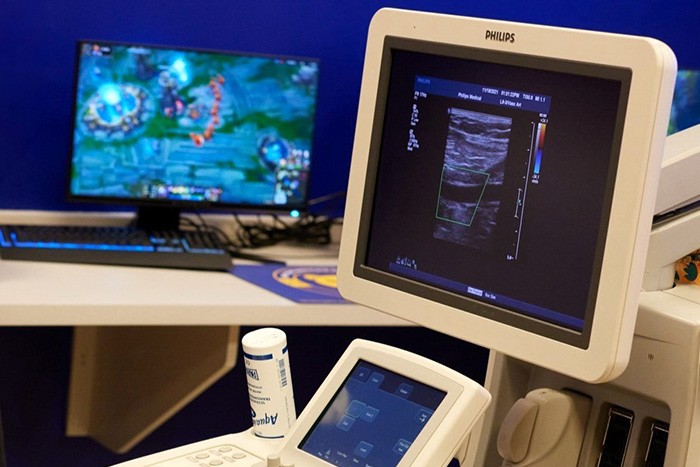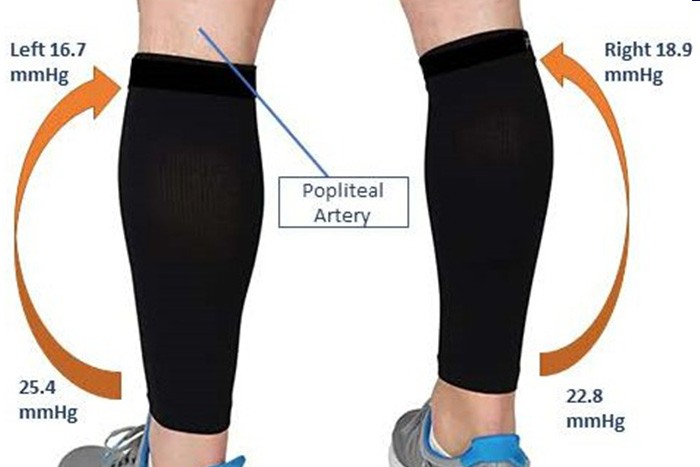Preventing Blood Clots in Gamers
As competitive esports continues to grow in popularity, blood clots formed in the legs, or deep vein thromboses (DVT), are being increasingly reported in gamers, the majority of whom play between three and 10 hours per day. In fact, given the number of continuous hours spent being sedentary, gamers have nearly double the risk of developing these blood clots, which can become life-threatening, especially if the clot travels to the lungs.
A new study from researchers at New York Tech’s Center for Esports Medicine analyzes whether compression sleeves worn below the knee or short walking breaks can enhance blood flow and reduce DVT risk in gamers. But the findings don’t just apply to gamers—they could help anyone who sits for an extended period of time, including office workers.
The research, which published on February 8 in the American Journal of Physiology—Heart and Circulatory Physiology, is the outcome of a collaboration with the global esports organization Fnatic.
Over the course of three visits, the researchers analyzed 10 healthy, college-aged gamers, all of whom were ranked esports players with more than 500 hours of playing time. In one visit, players engaged in two hours of uninterrupted, continuous gameplay with no interventions. In a second visit, gameplay was interrupted halfway through, and players took part in a six-minute walking break at a comfortable pace. On a third visit, players wore a fitted compression sleeve below the knee while playing continuously for two hours.
Using Doppler ultrasound, the researchers took measurements of the players’ left popliteal artery, a primary vessel that delivers blood to the area near the knee and lower leg and is prone to blood clots. The recordings, taken at 30, 60, 90, and 120 minutes, collected data on vessel diameter, blood flow velocity, and blood flow volume. After the experiments were completed, participants were then also asked to reflect on each intervention and how they felt it affected their gaming performance.
The findings showed that during the two hours spent playing without any intervention (no compression sleeve or walking break), players experienced a greater decrease in blood flow and blood velocity, with blood flow volume dropping 46 percent after two hours.

When the compression sleeve was used, blood flow decreased by 31 percent at this time, offering moderate benefits over the control group. However, the six-minute walking break proved superior, with players experiencing a 20 percent decrease at the two-hour mark. These findings build on the center’s 2021 research, which found that walking breaks can improve gamers’ processing speed and executive function.
The player survey responses revealed that more than 67 percent believed that the walking break had a positive impact on their gaming performance, whereas only 11 percent felt the compression garments positively impacted performance. Interestingly, more than 78 percent still agreed that they would consider wearing compression garments in the future.

While the research stands to benefit any gamer who plays continuously—professional, collegiate, or even recreationally—lead author Joanne Donoghue, Ph.D., professor and director of clinical research at the College of Osteopathic Medicine (NYITCOM), notes that the findings could also improve health outcomes in any individual who sits for a prolonged period.
“Any person who sits for a long time throughout the day could benefit from our findings and apply this knowledge to reduce their risk of developing blood clots,” she says.
Donoghue also hopes her team’s findings will help establish the first health guidelines for collegiate esports players.
“As collegiate esports continues to grow, we’ve seen that coaches are desperate for information on how to make their players healthier. However, because esports is not yet NCAA-regulated, there are no available health regulations like those that exist for traditional sports, such as football. Hopefully, our research will inspire additional studies and conversations that eventually lead to these much-needed rules at the college level,” Donoghue told the journal’s podcast.
The study outcomes will be shared with Fnatic’s High-Performance Unit, a team of sports scientists who assess and leverage data to inform the creation of Fnatic’s physical and digital products.
Other New York Tech researchers include:
NYITCOM students
- Kelly Borges, who is pursuing a Doctor of Osteopathic Medicine and Ph.D. in Medical and Biological Sciences
- Timothy Li
- Olivia Ballone
Faculty
- Assistant Dean of Clinical Operations Hallie Zwibel, D.O., who also serves as director of the Centers for Sports Medicine and Esports Medicine
- Former School of Health Professions faculty member Peter Douris
Last fall, Donoghue and team published another Fnatic-sponsored study in the journal BMC Sports Science, Medicine, and Rehabilitation. Those findings showed that upper body compression wear increased muscle oxygenation following intense gaming, improving recovery.
More News

“Match” Madness
On March 21, members of NYITCOM’s Class of 2025 discovered where they will complete their residency training.

Medical Students Receive Residency “Marching Orders”
Upon graduating this spring, 14 members of NYITCOM’s Class of 2025 will complete their residency training in the U.S. Armed Forces.

A Call to Medicine
After her grandfather was seriously injured in a collision and witnessing his lack of access to specialists, Harley Duncan decided she wanted to be part of the solution. With the goal of becoming a neurologist, she is committed to practicing near the underserved community where she was raised.

Pioneering NYITCOM Cardiologist Recognized by the National Academy of Inventors
Todd J. Cohen, M.D., is one of 170 exceptional innovators elected to the organization’s 2024 Class of Fellows. The fellowship is the highest professional distinction awarded solely to inventors.

OMM Lab Rededication Ceremony Honors NYITCOM Founder
On December 6, NYITCOM celebrated the grand reopening and rededication of the NYITCOM Osteopathic Manipulative Medicine Lab, honoring the legacy of Stanley Schiowitz, D.O., founder, chairman, and dean of NYITCOM.

More Than a Medical School
NYITCOM-Arkansas is delivering on its mission to increase the number of physicians and reduce healthcare inequity in the Delta region.